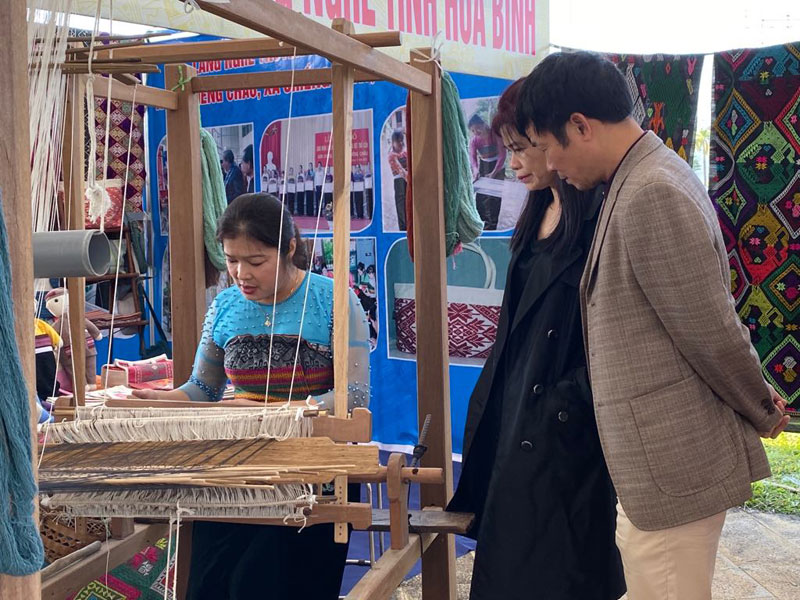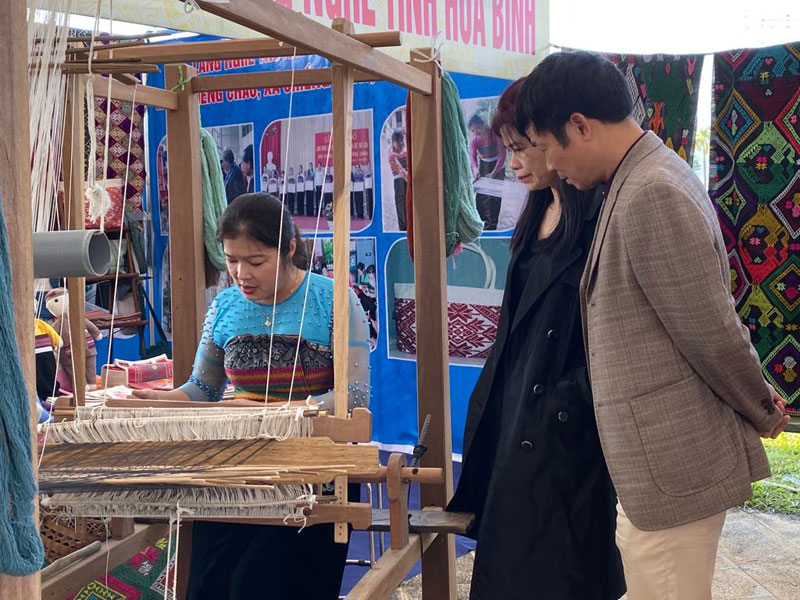
(HBO) - Occupations, craft villages and traditional trade villages are potentials and advantages of Mai Chau upland district. In particular, on the momentum of developing tourism, craft villages and traditional trade villages have created products with bold national identity and cultural values, helping domestic and international tourists coming here to have more experiences.

Tourists are visiting and experiencing brocade weaving in Chieng Chau hamlet, Chieng Chau commune (Mai Chau).
On the recent journey exploring the villages in Hang Kia and Pa Co, visitors have an additional attractive address, which is the Brocade weaving village of the Mong ethnic people. Different from Thai and Muong craft villages, Mong's weaving products are made of flax and indigo trees. From natural materials, the worker must go through many stages, even it takes months to make a product.
Mr. Phang A Pao - a household doing community tourism in Pa Co says along with interesting experiences such as watching the sunrise in the early morning, exploring the jungle, visiting the village, visitors especially foreigners really love visiting brocade weaving village of Mong ethnic people. They are impressed by the way that people make products entirely by hands with skillful and sophisticated patterns. In 2018, with the province's financial support to promote the development of trades, craft villages and traditional trade villages, brocade weaving village in Pa Co hamlet, Pa Co commune has been recognized. Through the local tourism activities, the products of the weaving village have been increasingly improved in terms of quality and aesthetic value, helping to bring significant revenue to the local people and meeting the needs of visiting and learning of tourists, which has created a new look for the village.
For a long time, Chieng Chau Brocade Weaving Cooperative has been known to the community for its active activities of preserving and promoting the traditional brocade weaving of Thai ethnic people, improving the livelihoods of the women in the area. Ms. Vi Thi Oanh, the Deputy Director of the cooperative says in order to develop the commodity market, craft villages and traditional trade villages must retain the core cultural values reflected on the products they make. The reason why Chieng Chau Brocade Weaving Cooperative attracts thousands of domestic and international tourists every year is that the traditional identity of the weaving profession is preserved and the mode of production is still the way that was used a long time ago by the ancestors.
Additionally, the women in the village with the skillful hands and creativity also have made a variety of bags, stuffed animals, pillows, shoes to meet the customers’ needs. In 2019, the Provincial People's Committee recognized the traditional craft village of brocade weaving for Chieng Chau hamlet, Chieng Chau commune. Accordingly, the tourism potential for the handicraft village has been expanded, the products of handicraft villages have had better consumption markets both at home and abroad. The average income per worker in the trade village is currently about 4.5 million dongs a month. Particularly, Ching Chau Brocade Weaving Cooperative maintains regular jobs and stable income for 20 women.
According to Mr. Ha Cong Soan, the Head of the Department of Agriculture and Rural Development, the activities of the craft villages in the district have been promoted in association with the propaganda to preserve the inherent identity to develop community tourism to raise income of the rural residents.
Among the 11 craft villages and traditional trade villages recognized throughout the province, Mai Chau district has 5 handicraft villages. They are brocade weaving of Lac village, brocade weaving of Chieng Chau hamlet in Chieng Chau commune, brocade weaving of Pa Co Con hamlet in Pa Co commune, brocade weaving of Nhon village in Na Phon commune and Mai Ha wine making village in Mai Ha commune. A number of other crafts and trade villages are being studied for conservation and development in association with tourism in the following years, for example, Pa Co commune has been proposed to conserve knife-forging craft of Mong ethnic people.
In the structure of economic development, the district has determined to reduce the proportion of agriculture and forestry, increase the proportion of tourism and services. Accordingly, the conservation and development of craft villages and traditional trade villages have an important contribution to promoting community tourism, and at the same time it is the tourism product bringing economic income and promoting the cultural identity to domestic and international tourists.
A diverse chain of eco-tourism and resort destinations concentrated in Hoa Binh city and the districts of Tan Lac, Da Bac, and Luong Son… Along with the launch of several key high-quality resort tourism projects, these developments have reshaped the landscape and enhanced the appeal of Hoa Binh as a travel destination.
Boasting diverse terrain, a mild climate, and rich natural resources, Cao Phong district is increasingly asserting its place on Vietnam’s tourism map, attracting both domestic and foreign visitors. The district is renowned for its stunning landscapes, majestic mountains, a crystal-clear hydropower lake, and the unique cultural identity of local ethnic groups.
With its pristine landscapes, unique cultural heritage of Muong ethnic minority, and an expanding range of visitor experiences, Tan Lac district of Hoa Binh has fast become a captivating destination for both domestic and international tourists.
Until now, Sung village in Cao Son commune, Da Bac district remains the only Dao ethnic community in Hoa Binh province to develop a community-based tourism model. Beyond its untouched natural landscapes, cultural identity serves as the cornerstone attraction for visitors.
Alongside the diverse cultural identities of the Kinh, Muong, Tay, Thai, Dao, and Mong ethnic people, Hoa Binh province is also renowned as the "capital" of the northwestern Vietnamese cuisine, offering unique and distinctive dishes. At festivals, during Lunar New Year (Tet), or on significant family or community occasions, special dishes are prepared, leaving a lasting impression on visitors.
A Phong Linh (Yellow Tabebuia) flower garden in Thang village, Thach Yen commune, Cao Phong district is currently in full bloom, drawing a large number of visitors.



